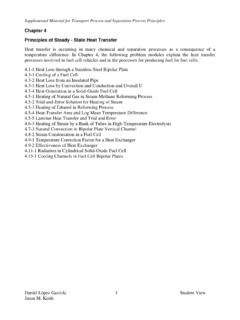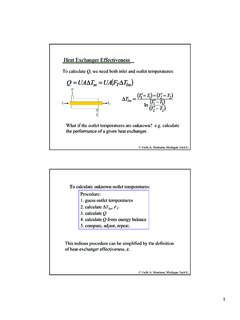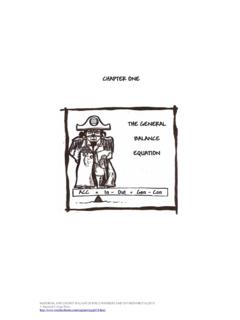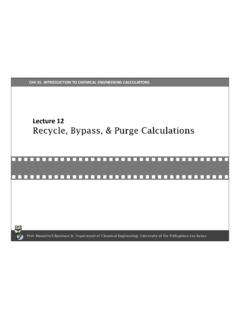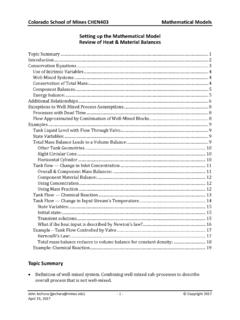Transcription of Note: This document represents a draft of text that is ...
1 C 2005 Faith A. Morrison, all rights 9, 2005 Note: This document represents a draft of text that is published in the following book:Faith A. Morrison, "An Introduction to Fluid Mechanics," Cambridge University Press, 2005 Faith A. Morrison, all rights energy balance : Intro and OverviewFaith A. MorrisonProfessor of Chemical EngineeringMichigan Technological UniversityJune 9, 20052c 2005 Faith A. Morrison, all rights energy balance : Intro andOverviewFaith A. Morrison Professor of Chemical EngineeringMichigan Technological University, Houghton, MI 499319 June 2005 The mechanical energy balance is a type of energy balance that can tell us a great deal about simple flow systems.
2 We begin with a discussion of conservation of energy and derive the mechanical energy balance (MEB). Finally, we show how to apply the MEB to simple flow energy BalancesThe First Law of Thermodynamics expresses a fundamental law of physics: energy is con-served. energy can be neither created nor destroyed (just like mass and momentum), but energy can move across the boundaries of a system, increasing or decreasing the total systemenergy. Increase in theTotal Energyin a system = Net Energyinto thesystem (1) energy can cross system boundaries in a variety of ways.
3 One is in the form of heat, andanother is in the form of work. The third way energy enters or leaves a system is when it iscarried along by material entering or leaving the system, a mechanism know as convection. Etotal+ Econvection=Qin+Won(2)In the energy balance above,Etotalis the total energy of the system,Qinis the heat thatflows into the system,Wonis the total work done on the system, and Econvectionis the netenergy out by heat that flows out is equal to Qin, and the work donebythe system is equal to term for net- energy -in placed on the right-hand side of equation 2 might seem a better choice fornotation.
4 The choice is arbitrary. Net- energy -out is more convenient to use in steady state analysis, as wewill see in a 2005 Faith A. Morrison, all rights total energy of the system has contributions from three types of energy , thekinetic energy of the system, the potential energy of the system, and the internal energy ofthe system (Felder and Rousseau, Tipler; Figure 1). The kinetic energy is the energy duevhz=0=zgFigure 1: energy is a property of a system. energy may be stored in the state of a system,for example, as kinetic energy stored in the speed of the system, as potential energy storedin the position of the system in a potential field, or as internal energy stored in the chemicalstate of a the speed at which the system is moving.
5 To calculate the kinetic energy , first we mustchoose a reference state; for kinetic energythe reference state is the system at rest,v= to a system at rest, the kinetic energy of a system moving with speedvis given by Kinetic Energyof a system movingwith speedv =12mv2=Ek(3)wheremis the mass of the system, andvis the speed of the potential energy is the energy of the system by virtue of the position of the systemin a potential field. The most important potential fields are gravity and electromagneticfields. Potential energy in the Earth s gravitational field is the energy that the system hasby virtue of its being at a high elevation.
6 A ball, for example, can roll down a hill andexchange its potential energy (the energy it had stored in it simply by being at the top ofthe hill) for kinetic energy (speed). Again energy is calculated relative to a reference potential energy we choose a reference elevation (or position), and then measure theelevation of the system relative to that reference elevation. The potential energy of a system4c 2005 Faith A. Morrison, all rights therefore given by Potential Energyof a system atelevationz =mg(z zref)=Ep(4)wheremis the mass of the system,gis the acceleration due to gravity, and (z zref)isthe elevation of the system relative to the reference chosen to bez=0,andEp= energy is the energy possessed by a system internally, that is, in its moleculesand atoms.
7 The temperature of a system is one indicator of its internal energy , but a systemmay store internal energy in its phase (being a solid versus being a liquid, for example) orin its chemical composition (being a mixture of gassesH2andO2versus being a beaker ofH2O). Internal energy is kept track of with the defined functionU. Again, the value ofUreported for a system is always with respect to some chosen reference state. Internal Energyof a systemwith respect toa chosen referencestate =U(5)The reference state for internal energy must fully describe the internal energy of the example we might choose liquid water at temperature 25oCas the reference state fora calculation involving steam.
8 We must specify temperature (25oCin this example), phase(liquid), and chemical composition (H2O) in order to fully specify the internal key to getting the most information out of energy balances is making the correctthe choice of system on which to base the Closed Systems (No Convection)Balances of many types, for example mass, energy , or momentum, may be performed onany system, but not all systems are equallyuseful. A system is defined by boundariesdrawn around components of a physical situation under consideration.
9 When we write ourbalance equations we choose the boundaries and then note the quantities of mass, energy , ormomentum that cross the boundaries (Figure 2).A closed system is a system that does not have any mass crossing its boundaries. Forclosed systems, there is no mass coming in or going out and thus no convection of mass, energy , or a closed system, the energy balance relates two states of the system, an initial stateand a final state. The changes in energy between initial and final states of the system arec 2005 Faith A.
10 Morrison, all rights pump tank Different systemboundaries 500g fluid fluidFigure 2: System boundaries are chosen for convenience of the calculation. Usually the sys-tem boundaries are chosen so that the inputs andoutputs to the system are locations wherefluid velocities, pressures, and/or elevations are known. Some problems require multiplebalances over different about by additions of energy through heat (Qin) and additions of energy throughwork done on the system (Won). Etotal=Qin+Won(6)The total energy change of the system, Etotal, is calculated by summing the changes inpotential, kinetic, and internal energy .



